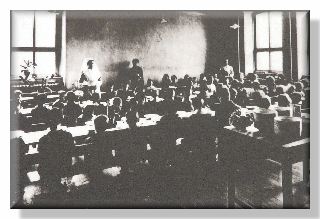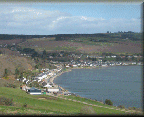1920 there was no general provision of meals to pupils, but some schools provided soup or cocoa with bread, using local funds.
Drinking water which was kept under teacher supervision, was provided in a covered vessel with a tap and a drinking cup.
The economic conditions of the country in the 1920s were reflected in the poor health of the children. Large numbers of parents were unemployed and country children had to walk long distances in all kinds of weather over poor roads. The children often showed signs of malnutrition and illness. The Ministry of Health (MOH) suggested that a warm midday meal was of special importance in the winter months.
Although the MOH stated in 1941 that there was no evidence of the war having a detrimental effect on diet, canteen meals centres developed in the early 1940s. Canteen equipment became available from the Ministry of Food and the suggested wages for a woman to prepare food and wash up was 20/- to 25/- (£1 to £1.25) per week.
In 1940, Avoch Public School applied for a grant of £12 10/- per annum (£12.50) towards their soup kitchen. A local sub-committee was formed in 1943 to view the policy of charging children for the cost of food only, with the Education Authority meeting the cost of fuel, equipment and service. It was decided that the cost of meals should be not less than 5d per pupil, and that the Authority should consider the cost of transporting food to rural schools in thermal containers.
It was September 1947 before the Avoch canteen was in use, and by that time there were 11 canteens in the County, with the smaller schools still providing cocoa at midday. The number of canteens grew steadily from 13 in 1948 to 19 in 1949, with canteen assistants being issued with overalls, price 13s 1d, in the interests of cleanliness. By this time 62 schools received Tuberculin Tested morning milk, with 23 schools having National Dried Milk.

It was the considered opinion in 1951 that the School Meals Service was assisting the development of country children, particularly those who walked long distances to school.
By 1957, 6011 pupils were having meals in the county, with children in general being not only healthier. but much better clothed and fed.
